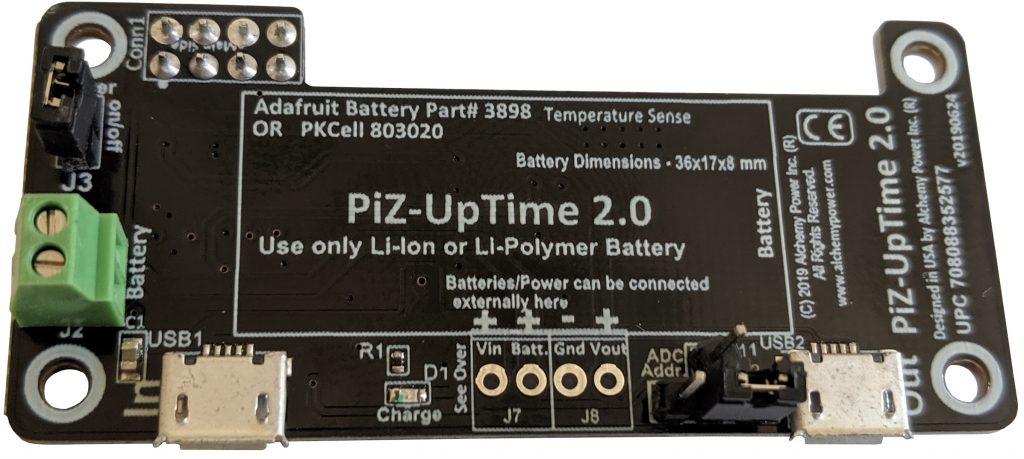Overview
Features
Datasheet
Downloads
FAQ
Supported Models
Image Gallery
ebay Amazon tindie UPC 708088352577

PiZ-UpTime 2.0 provides Uninterruptable Power Supply (UPS) for a Raspberry Pi Zero, other Pi models and other USB Single Board Computers (SBC) such as Odroid, Asus etc. (See Comparison Chart between original model and the updated version 2 model). Power is provided via the USB-out port or the 40-pin Raspberry Pi compatible header. The board has the same dimensions as a Pi Zero and can be mounted securely on a Raspberry Pi Zero using spacers for a compact, mechanically stable connection. When used with a Pi Zero 40-pin header (e.g. Pi Zero W H), UPS power is provided via the header pins. UPS power can also be provided via the micro USB Out port. A micro-USB to micro-USB cable is needed (not supplied).
An on-board 12-bit ADC monitors Vin, Vout, battery Voltage and operating Temperature (in oC and oF) providing accurate operating conditions. Temperature sensor (via an on board NTC) below the battery area provides approximate battery temperature or the operating temperature of PiZ-UpTime 2.0. Battery charging is usually safe between 0oC and 50oC. Recommend getting the operating temperature range of the battery from the manufacturer.
No GPIO connections or GPIO monitoring is needed. The on-board ADC provides information via the I2C. Up to three different I2C addresses can be selected via jumper J11-J12 to avoid conflict with other I2C devices.
External connections are available for Vin, Battery and Vout via jumper studs, terminal blocks or JST connectors. The external connection points can be used for an external battery[1], external Vin of 5V and 5V Vout.
Max UPS and operating current for the system is 2A. External battery can be Li-Polymer or Li-Ion connected via a terminal block. Please make sure to connect the battery with the proper polarity. Incorrectly inserting the battery will burn out the electronics.
PiZ-UpTime has been sold and used word-wide. This version is an improvement to the older version. A comparison table is provided below for users familiar with PiZ-UpTime.
Maximum current is limited to 2A via a current limit resistor. Since the USB connector provides power for charging the battery and providing power to devices connected via Pi-UpTime-UPS 2.0, a 3.5A power supply is strongly recommended. A good quality USB cable will minimize power loss.
Back to the Top
Features
- Provides UPS functionality for Raspberry Pi Zero and other Pi models.
- Use Li-Ion or Li-Polymer batteries. Batteries not included.
- 5V, 2A UPS out.
- Batteries attach via terminal block.
- No reboot when power fails. UPS takes over.
- Ideal diode power OR between UPS and USB power. No heat.
- Monitor Input, Output, Battery Voltage and temperature via ADC. Up to three I2C addresses.
- Add power on/off switch. All power to the Pi is off when off.
- No GPIO’s used.
Back to the Top
Pi Models Supported
 The PiZ-UpTime 2.0 product ships with the 2×4 pin connector soldered. Besides the Pi-Zero family of products, the connector on PiZ-UpTime 2.0 will also work with the Raspberry Pi (models A+, B+, Pi-2 and Pi-3, Pi-4, and other vendors adhering to the HAT pin and dimension standard). Some Pi-Zero products require you to solder the 40 pin header to the Pi-Zero, to leverage the full functionality (monitoring and shutdown via the Python script). If the header is not soldered, a micro-USB to micro-USB cable (not included) can be used to connect the PiZ-UpTime 2.0 to the Pi-Zero for UPS capability, however, the parameters cannot be monitored via the on-board ADC. The mounting holes for Pi-Zero match the two mounting holes on a Raspberry Pi (models A+, B+, Pi-2 and Pi-3, Pi-4). Using a PiZ-UpTime 2.0 on a Pi (models A+, B+, Pi-2 and Pi-3, Pi-4) only two standoffs can be used.
The PiZ-UpTime 2.0 product ships with the 2×4 pin connector soldered. Besides the Pi-Zero family of products, the connector on PiZ-UpTime 2.0 will also work with the Raspberry Pi (models A+, B+, Pi-2 and Pi-3, Pi-4, and other vendors adhering to the HAT pin and dimension standard). Some Pi-Zero products require you to solder the 40 pin header to the Pi-Zero, to leverage the full functionality (monitoring and shutdown via the Python script). If the header is not soldered, a micro-USB to micro-USB cable (not included) can be used to connect the PiZ-UpTime 2.0 to the Pi-Zero for UPS capability, however, the parameters cannot be monitored via the on-board ADC. The mounting holes for Pi-Zero match the two mounting holes on a Raspberry Pi (models A+, B+, Pi-2 and Pi-3, Pi-4). Using a PiZ-UpTime 2.0 on a Pi (models A+, B+, Pi-2 and Pi-3, Pi-4) only two standoffs can be used.
Older models of the Raspberry Pi with a 26 pin header are not supported
